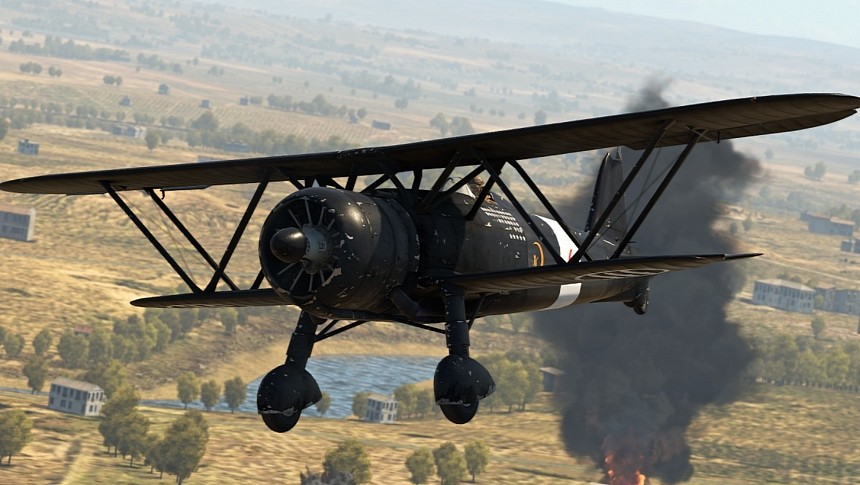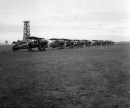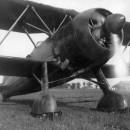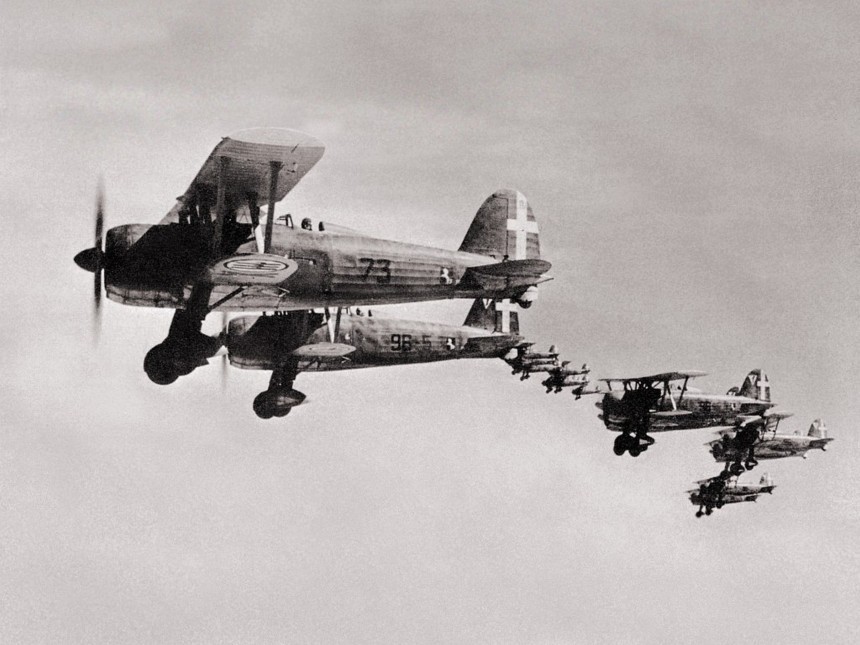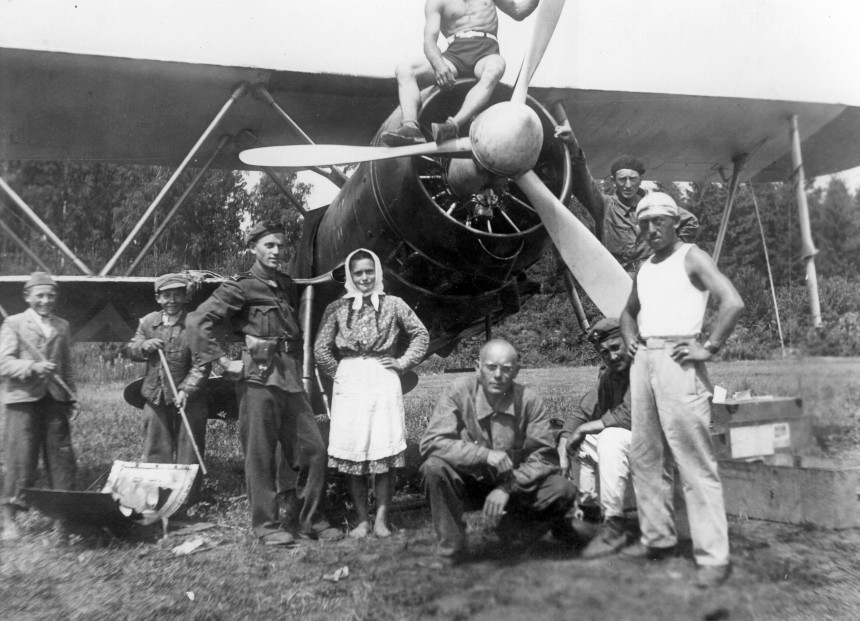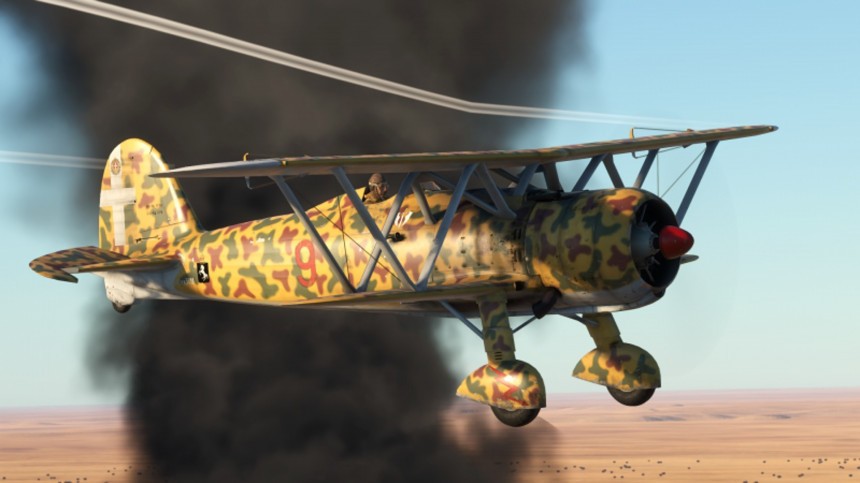Let's be honest. Certain eras of military aviation are held in higher regard than others. World War Two is at the top of this hierarchy, obviously. While Korea, Vietnam, and maybe the Six Day War and Desert Storm all take other subjective places on the totem pole. Everyone has their preferences, but the era between the World Wars is often at the bottom of an aviation geek's priority list. If you ask us, that's a shame.
Why? Because it means people wind up disregarding the more exciting and unique fighter planes built during this time. Airplanes like the Fiat CR.42 Falco, for example. A full nine years before the founding of Ferrari, the CR.42 was like an Italian sports car in the sky. As a zippy, maneuverable firebrand of a sesquiplane built by a team firm nearly as old as Italian aviation itself, it's time we acknowledged the Falco after so long in the shadow of equivalent German hardware.
In many ways, the CR.42 Falco was the kind of fighter plane that only the Italians could build. Fiat Group had only been manufacturing automobiles for less than ten years when their aviation operation, Fiat Aviazione, was established in 1908. While Fiat's automotive division was busy fielding 12-liter-plus monsters of race cars in competitions in Europe and North America, Fiat Aviazione was busy taking these same race car engines and retrofitting them for aeronautical service.
If that isn't the most Italian approach to the pioneer days of aviation, we don't know what is. More to the point, this firebrand approach to aviation formed the foundations for what the CR.42 Falco would one day become. In 1918, coincidentally, the same year Nicola Romeo purchased an Italian racing moniker and renamed it Alfa Romeo, Fiat Aviazione hired a man called Celestino Rosatelli at the behest of the Italian government. Rosatelli embraced the principles of low curb weight and big power in his aeronautical designs in a way Enzo Ferrari himself would have approved.
Rosatelli, a Central Italian native who moved north to Modena just to work for Fiat, had a hand in designing over 50 airplanes for the company, doing so under the R-series denoting the first letter in his surname. But never before was his genius more prominently displayed than with the lineage that spawned the Falco, beginning with the CR.30 in 1932. Like an excellent 1930s Italian race car in the sky, the CR.30 emphasized pairing lightweight construction materials and high degrees of mobility over raw horsepower or firepower.
Weighing in at just under 3,000 lbs (1,361 kg) sans pilot, a modern Ferrari SF90 Stradale is roughly 600 lbs (272 kg) heavier, for some context. Another fun fact, the CR.30's measured top speed was 218 mph (351 km/h), according to the 1985 book The Illustrated Encyclopedia of Aircraft by Orbis Publishing. The 2023 SF-90s is a paltry 211 mph (339.5 km/h), not bad for the early 1930s. The CR.30 platform was refined into the CR.32 by Celestino Rosatelli in 1933. With a sleeker, more aerodynamic fuselage and very light aluminum and steel tubular airframe, the CR.32 could even slug it out with mono-wing fighters considerably more advanced than itself.
By the late 1930s and early 40s, most air forces globally, even well-funded ones like the Soviets and Americans, had yet to fully transition from biplane military planes to sleeker mono-wing aircraft. During the Spanish Civil War preceding World War II, CR.32s flown by Spanish Nationalists slugged it out against Republican loyalist pilots in Soviet Poliparkov I-15s and I-16s. It was some of the most exhilarating and acrobatic dogfighting to happen in the interim between the World Wars, aerial battles that forged some of the last biplane fighter aces. Iconic Spanish pilots like Joaquín García Morato y Castaño and Capitán Manuel Vázquez Sagastizábal became among the first in the era to claim the title of ace while piloting an Italian aircraft.
Before long, CR.32s were fighting for the Italian Regia Aeronautica in campaigns over North Africa, the Middle East, Greece, and eventually over Italian soil. By 1943, the type was delegated to backup duty thanks to more advanced mono-wing fighters like the Macchi C.200 Saetta and C.202 Folgore, and even Fiat's own G.50 and G.55. But even before the first shots of World War were fired, Fiat was working on the perfect bookend to the era of biplanes, the CR.42. By ditching the CR.32's V12 engine for a supercharged 14-cylinder Fiat A.74 radial unit, the Falco gained an extra 240 horsepower over its predecessor, 840 in total.
Meanwhile, the aerodynamically sleek fuselage and sesquiplane wings the CR.32 took for granted were still ever-present in the CR.42 halo-vehicle. This made for a top speed of nearly 275 mph. Not exactly lightning quick by monoplane standards, but absolute witchcraft by 1930s biplane standards. The Falco bucked the trend of CRs carrying two 7.7 mm Breda SAFAT machine guns for armament like its predecessors.
Instead, early models replace one of these guns with a 12.7 mm unit from the same manufacturer. Along with hardpoints for two 440 lb (200 kg) bombs, this was the primary weapons loadout the CR.42 Falco flew into combat with during the Battle of France, the Battle of Britain, and Italian military engagements in Malta. With its extra set of wings, the Falco often outmaneuvered even the most nimble mono-wing Allied fighters at low speeds. Everything from Hawker Hurricanes to Spitfires and French Dewotine D.520s found themselves vanquished by squadrons of Italian Falcos during the war.
By the middle of World War II, CR.42s were flying with twin 12.7 mm guns mounted on underwing pylons to add extra firepower to ground attacks and occasional air-to-air engagements. Scarily, a few CR.42 Falcos were fitted with two more 12.7 mm guns on underwing fairings. When equipped with longer engine exhaust tips to shroud the visible plumes emitted, the CR.40 transformed into a monstrous night-fighter ground attack machine. One capable of strafing large collums of lightly armored vehicles or knocking out light and medium tanks with its bombs, depending on the loadout.
In the Air Forces of Hungary, Belgium, Italy, Sweden as the J-11, and even the German Luftwaffe, CR.42 pilots had mixed results overall. This is despite a few impressive stories of turning the tides against far faster and more capable mono-plane fighters. But in the Battles of Britain and France especially, Falco squadrons suffered a fair few losses for every kill. Even so, the type remained in reserve and non-front-line service with Axis forces throughout the Second World War. There are even disputed and unconfirmed reports of Luftwaffe CR.42s downing two P-38 Lightning twin-engine fighters as late as February 1945, less than two months before the end of the War in Europe.
If accurate, this would almost certainly be the final air-to-air kill of a mono-wing flighter plane by a biplane in history. Whether true or not, the victorious Spanish nationalists continued to employ CR.32s and CR.42 Falcos even past the end of World War II. In the case of the CR.32, some even served until 1953 as a trainer. Three years later, Fiat's first turbojet swept-wing fighter, the G.91, made its inaugural flight. By bridging the gap between primitive bi-planes with canvas-covered wings and the gas-turbine-powered future, the CR.42 is one of the most important aircraft ever to be produced in Italy.
Today, three complete CR.42s survive on display. Two are on display in England, one at the Royal Air Force Museum of London, another other in the private collection of the Fighter Collection in Duxford, Cambridgeshire, and another Swedish J-11 variant at the Swedish Air Force Museum in Linköping in Southern Sweden. On May 25th, 2017, the CR.42 was introduced to Gaijin Entertainment's vehicle-based combat game War Thunder under Update 1.69, "Regia Aeronautica," along with the CR.32.
As the two introductory aircraft to the then brand-new Italian aviation tech tree, players found the twin Fiat biplanes to be some of the most fun entry-level fighters to fly in the game. In these matches, gamers found that flying circles around early Mustangs, Spitfires, and Bf-109s like they're standing still is just as exhilarating in War Thunder as it was in real life. It's just the cherry on top for perhaps the greatest biplane fighter ever to fly.
In many ways, the CR.42 Falco was the kind of fighter plane that only the Italians could build. Fiat Group had only been manufacturing automobiles for less than ten years when their aviation operation, Fiat Aviazione, was established in 1908. While Fiat's automotive division was busy fielding 12-liter-plus monsters of race cars in competitions in Europe and North America, Fiat Aviazione was busy taking these same race car engines and retrofitting them for aeronautical service.
If that isn't the most Italian approach to the pioneer days of aviation, we don't know what is. More to the point, this firebrand approach to aviation formed the foundations for what the CR.42 Falco would one day become. In 1918, coincidentally, the same year Nicola Romeo purchased an Italian racing moniker and renamed it Alfa Romeo, Fiat Aviazione hired a man called Celestino Rosatelli at the behest of the Italian government. Rosatelli embraced the principles of low curb weight and big power in his aeronautical designs in a way Enzo Ferrari himself would have approved.
Rosatelli, a Central Italian native who moved north to Modena just to work for Fiat, had a hand in designing over 50 airplanes for the company, doing so under the R-series denoting the first letter in his surname. But never before was his genius more prominently displayed than with the lineage that spawned the Falco, beginning with the CR.30 in 1932. Like an excellent 1930s Italian race car in the sky, the CR.30 emphasized pairing lightweight construction materials and high degrees of mobility over raw horsepower or firepower.
By the late 1930s and early 40s, most air forces globally, even well-funded ones like the Soviets and Americans, had yet to fully transition from biplane military planes to sleeker mono-wing aircraft. During the Spanish Civil War preceding World War II, CR.32s flown by Spanish Nationalists slugged it out against Republican loyalist pilots in Soviet Poliparkov I-15s and I-16s. It was some of the most exhilarating and acrobatic dogfighting to happen in the interim between the World Wars, aerial battles that forged some of the last biplane fighter aces. Iconic Spanish pilots like Joaquín García Morato y Castaño and Capitán Manuel Vázquez Sagastizábal became among the first in the era to claim the title of ace while piloting an Italian aircraft.
Before long, CR.32s were fighting for the Italian Regia Aeronautica in campaigns over North Africa, the Middle East, Greece, and eventually over Italian soil. By 1943, the type was delegated to backup duty thanks to more advanced mono-wing fighters like the Macchi C.200 Saetta and C.202 Folgore, and even Fiat's own G.50 and G.55. But even before the first shots of World War were fired, Fiat was working on the perfect bookend to the era of biplanes, the CR.42. By ditching the CR.32's V12 engine for a supercharged 14-cylinder Fiat A.74 radial unit, the Falco gained an extra 240 horsepower over its predecessor, 840 in total.
Meanwhile, the aerodynamically sleek fuselage and sesquiplane wings the CR.32 took for granted were still ever-present in the CR.42 halo-vehicle. This made for a top speed of nearly 275 mph. Not exactly lightning quick by monoplane standards, but absolute witchcraft by 1930s biplane standards. The Falco bucked the trend of CRs carrying two 7.7 mm Breda SAFAT machine guns for armament like its predecessors.
By the middle of World War II, CR.42s were flying with twin 12.7 mm guns mounted on underwing pylons to add extra firepower to ground attacks and occasional air-to-air engagements. Scarily, a few CR.42 Falcos were fitted with two more 12.7 mm guns on underwing fairings. When equipped with longer engine exhaust tips to shroud the visible plumes emitted, the CR.40 transformed into a monstrous night-fighter ground attack machine. One capable of strafing large collums of lightly armored vehicles or knocking out light and medium tanks with its bombs, depending on the loadout.
In the Air Forces of Hungary, Belgium, Italy, Sweden as the J-11, and even the German Luftwaffe, CR.42 pilots had mixed results overall. This is despite a few impressive stories of turning the tides against far faster and more capable mono-plane fighters. But in the Battles of Britain and France especially, Falco squadrons suffered a fair few losses for every kill. Even so, the type remained in reserve and non-front-line service with Axis forces throughout the Second World War. There are even disputed and unconfirmed reports of Luftwaffe CR.42s downing two P-38 Lightning twin-engine fighters as late as February 1945, less than two months before the end of the War in Europe.
If accurate, this would almost certainly be the final air-to-air kill of a mono-wing flighter plane by a biplane in history. Whether true or not, the victorious Spanish nationalists continued to employ CR.32s and CR.42 Falcos even past the end of World War II. In the case of the CR.32, some even served until 1953 as a trainer. Three years later, Fiat's first turbojet swept-wing fighter, the G.91, made its inaugural flight. By bridging the gap between primitive bi-planes with canvas-covered wings and the gas-turbine-powered future, the CR.42 is one of the most important aircraft ever to be produced in Italy.
As the two introductory aircraft to the then brand-new Italian aviation tech tree, players found the twin Fiat biplanes to be some of the most fun entry-level fighters to fly in the game. In these matches, gamers found that flying circles around early Mustangs, Spitfires, and Bf-109s like they're standing still is just as exhilarating in War Thunder as it was in real life. It's just the cherry on top for perhaps the greatest biplane fighter ever to fly.
